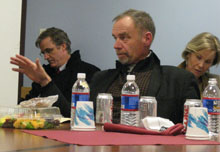Event
David Carr: News organizations must build their future

March 3, 2009 — Judging from his Shorenstein Center brown-bag talk, “Fallen Sky: Finding a Way Forward After the Media Shakeout,” New York Times media columnist David Carr is equal parts pessimist and optimist.
What did Carr think of the recently announced cancellation of the 2009 newspaper editors’ convention? “An extinction event,” he said in a somber voice. And what did the closure of the Rocky Mountain News after nearly 150 years foretell for regional papers? “I see a great burn-down, a forest fire.” But what of news organizations creating great websites and giving away their content for free? “Erecting your own gallows,” Carr stated. “We got into the eyeball business at precisely the wrong moment.”
And what of the alternatives to newspapers’ traditional business model that have been proposed? Carr felt that micropayments won’t fly (“The analog between music and newspapers isn’t the same thing”) and that nonprofits aren’t the way forward. “There has to be a business model,” he said, noting that even if the nonprofit status of a publication such as Mother Jones allowed it to be fully staffed, “You have to think that somehow the funders come over the shoulders.” The Christian Science Monitor‘s having gone to a primarily online presence is “a survival effort,” Carr admitted, but said “they haven’t really been in the thick of things.”
And yet amid the darkness, Carr saw flashes of light, again and again. “I’m very bullish about our long-term prospects,” he said. While there was profound change going on in the industry, “the aggregate newspaper audience is far and beyond what it ever was.” Efforts such as GlobalPost were “tremendously exciting,” and sites such as Politico.com and the Huffington Post had important roles to play. But when it came to helping people truly understand the world, Carr felt that one delivery method had all the others beat — print.
“I spend a lot of time on the grid,” said Carr, who writes a business column for the Times that focuses on media issues and also works as a popular-culture reporter for the paper. “I’m very digitally involved, but I get five newspapers delivered to my house every day. [Print] is the only way I’m going to accrue a broader understanding of the world out there.” He then described a recent experience reading a newspaper that clarified his understanding of what was happening at that moment in time. “What to some people is a museum piece to me is a glorious creation.”
The challenge for news organizations is to “build our future,” Carr said, adding, “This is a fight to the death. This is the year.” He praised Yahoo’s recent effort to team with newspapers to sell ads, and said that organizations needed to “create scarcity,” making their content worth paying for. The Arkansas Democrat Gazette, one of the few newspapers to have always charged for online access to its content, had created what Carr felt was “a killer app” — “ferocious, deep reporting.”
This article was written by Leighton Walter Kille and the photos taken by Janell Sims, both of the Shorenstein Center.